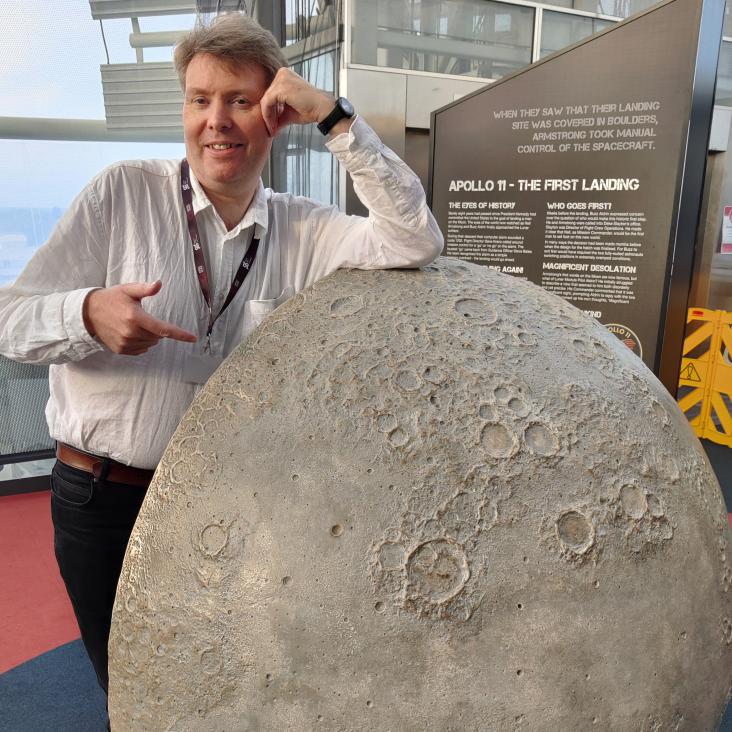Space weathering effects in Diviner Lunar Radiometer multispectral infrared measurements of the lunar Christiansen Feature: Characteristics and mitigation
Icarus Elsevier 283 (2016) 343-351
Abstract:
Multispectral infrared measurements by the Diviner Lunar Radiometer Experiment on the Lunar Renaissance Orbiter enable the characterization of the position of the Christiansen Feature, a thermal infrared spectral feature that laboratory work has shown is proportional to the bulk silica content of lunar surface materials. Diviner measurements show that the position of this feature is also influenced by the changes in optical and physical properties of the lunar surface with exposure to space, the process known as space weathering. Large rayed craters and lunar swirls show corresponding Christiansen Feature anomalies. The space weathering effect is likely due to differences in thermal gradients in the optical surface imposed by the space weathering control of albedo. However, inspected at high resolution, locations with extreme compositions and Christiansen Feature wavelength positions - silica-rich and olivine-rich areas - do not have extreme albedos, and fall off the albedo- Christiansen Feature wavelength position trend occupied by most of the Moon. These areas demonstrate that the Christiansen Feature wavelength position contains compositional information and is not solely dictated by albedo. An optical maturity parameter derived from near-IR measurements is used to partly correct Diviner data for space weathering influences.Dual-telescope multi-channel thermal-infrared radiometer for outer planet fly-by missions
Acta Astronautica Elsevier 128 (2016) 628-639
Abstract:
The design of a versatile dual-telescope thermal-infrared radiometer spanning the spectral wavelength range 8–200 µm, in five spectral pass bands, for outer planet fly-by missions is described. The dual-telescope design switches between a narrow-field-of-view and a wide-field-of-view to provide optimal spatial resolution images within a range of spacecraft encounters to the target. The switchable dual-field-of-view system uses an optical configuration based on the axial rotation of a source-select mirror along the optical axis. The optical design, spectral performance, radiometric accuracy, and retrieval estimates of the instrument are discussed. This is followed by an assessment of the surface coverage performance at various spatial resolutions by using the planned NASA Europa Mission 13-F7 fly-by trajectories as a case study.The Red Edge Problem in asteroid band parameter analysis
Meteoritics and Planetary Science Wiley 51:4 (2016) 806-817
A deep space inventory tour of the main asteroid belt
Proceedings of the International Astronautical Congress, IAC 0 (2016)
Abstract:
A consortium of international scientists and industry partners are proposing the Main Belt Inventory Mission as a candidate in the next forthcoming ESA medium class mission call. The inventory mission will characterise a broad range of statistically significant asteroid samples throughout the Main Asteroid Belt (MAB). A 0.5 m aperture space-based telescope will conduct a detailed spectroscopic survey, observing thousands of objects from a range of 0.1-0.5 AU, and perform basic flybys of pre-selected targets. Each flyby will target an asteroid of a different size, taxonomic (sub)classes and orbital families, where spatially resolved spectral mapping and spectroscopy will be performed. Smaller and fainter passing targets will also be discovered, through opportunistic science, with dedicated star tracker-like cameras. Examining the compositional diversity across the asteroid population will provide a key tracer to understanding the dynamic evolution of the solar system, offer an insight into its early history and the origins of life forming material. Furthermore, by combing visible, near-infrared and thermal spectroscopy, the mission will unlock information on the major rock forming minerals, hydrated minerals, organics and primitive material found throughout the asteroid belt. Coarse UV mapping capability will search for weak OH emission bands, providing evidence of buried volatile (water) reservoirs. This will provide an additional link to fully understanding the meteorite record on Earth, and more importantly, place the returned samples from the up-and-coming Hayabusa-2 (JAXA) and OSIRIS-REx (NASA) missions in a wider geological context. The mission will provide an accurate description of the present day MAB population, and further refinements of the origins and evolution models of Near Earth Asteroids. This paper will report on the scientific justification and focus on the (sub-)system spacecraft design to perform a detailed inventory mission of the MAB. It includes an evaluation of the different system options and architecture designs. The baseline design is then presented, and further broken down for each subsystem. The science and mission objectives have been developed within the scope of the expected boundary conditions of the forthcoming ESA medium class mission call. It therefore necessitates a high TRL spacecraft, ready for launch within the 2028/32 timeframe on either a Vega-C (or Ariane 6) launch vehicle. The mission and system design is currently being developed through an ongoing mission study. Analysis is performed by a consortium of OHB System AG, Cranfield University and an association of scientists from different institutes and organisations. Concurrent engineering techniques are used throughout.Asteroid belt multiple fly-by options for m-class missions
Proceedings of the International Astronautical Congress, IAC 0 (2016)


